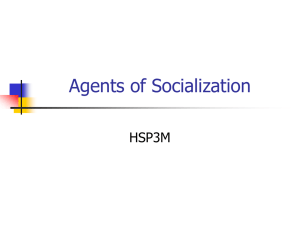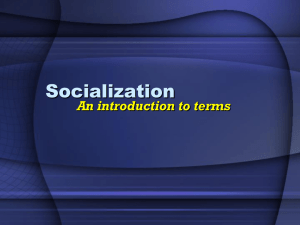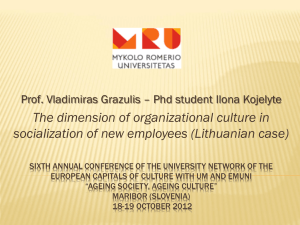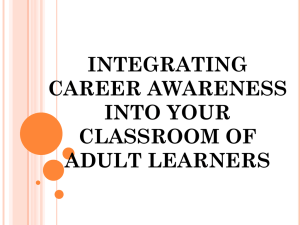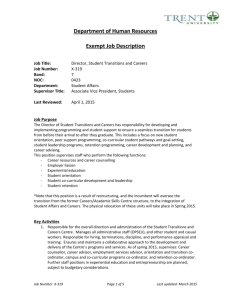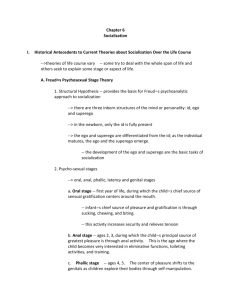View Slides
advertisement
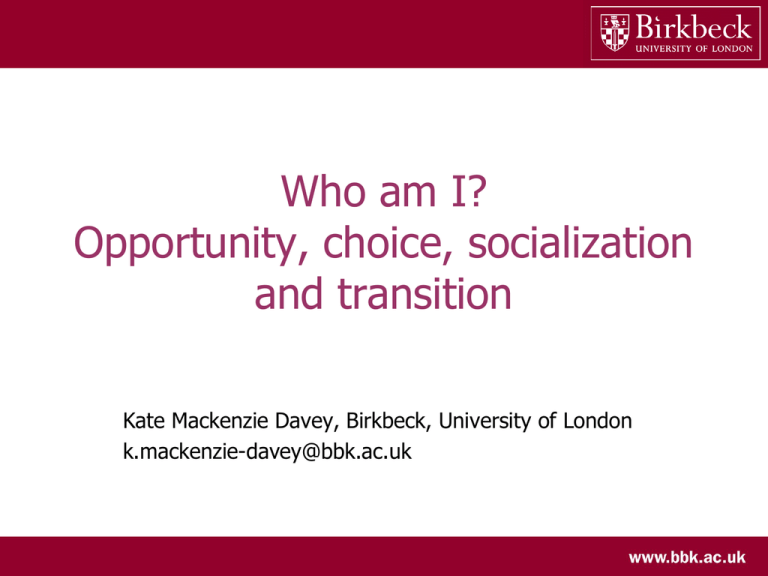
Who am I? Opportunity, choice, socialization and transition Kate Mackenzie Davey, Birkbeck, University of London k.mackenzie-davey@bbk.ac.uk Identity and work • • • • How did I come to be in this job? How was I socialised into this occupation? How is my work viewed by others? Where do I go from here? Self concepts and occupations • Vocation: Identification with a specific occupation • Experience: knowledge or awareness of occupations, possibly by chance • Rational decision making: awareness of possession of appropriate assets: • Both developmental and differential • Implement self concept • Development and choice combined in career adaptability (Savickas, 2005) Rational occupational choice • Person-environment fit (Parsons, 1909) – People are different – Jobs are different – By studying both we can get a good match between the two • Two groups of attributes – Rewards sought and satisfaction offered – Individual ability and job demands • Evidence suggests better fit leads to higher well being (Tinsley, 2000) • However, not all careers are equally rewarding or desirable Influence of early socialization • Socialised early within family – self concept, identity – expectations, feedback, support, modelling, information • Opportunity structure limits occupational choice – Structural and social class influences (Roberts, 1977) • Need to acknowledge both psychological, cultural and structural forces • Occupation choice embedded in social context and individual identity: reinforcing Joining work: Initial preparation and encounter • Socialization (Willis, 1977) • Contract negotiation (Herriot, 1987) • Climate of mutual selling (Schein, 1978) • Realistic previews (Wanous, 1977) • Reality shock (Hughes, 1958) • Change, contrast, surprise (Louis, 1981) Initial work socialization is influential. How far does this apply to job change? Work Socialization tactics Which of these apply to Medical training? • Collective or individual • Formal or informal • Sequential or random • Fixed or variable • Serial or disjunctive • Investiture or divestiture Institutionalised or individualised socialization? Institutionalised leads to • Passive acceptance of pre-set roles • Reproduces the status quo • Reduces uncertainty • Reduced role ambiguity • Reduced role conflict • Lower intention to quit • Increased fit to job and organization • Increased job satisfaction, commitment, performance • Custodial approach to role • Reduced innovation How to maintain security and increase innovation? 1986, Saks et al 2007) (Jones, Psychological contract • “an employee’s subjective understanding of promissory-based reciprocal exchanges between him and herself and the organization” (Conway & Briner, 2005, p.35) • Negotiations of development in exchange for capability, loyalty and flexibility (Rousseau, 1995; Herriot & Pemberton, 1996) Types of contract • • • • • • Relational Transactional Hybrid or balanced: (Dabos & Rousseau, 2004) Idiosyncratic (I-deals) (Greenberg, Roberge, Ho & Rousseau, 2004) Issues of fulfillment, breach and violation Tendency for employers to offer transaction and expect relational (Ho, Ang & Straub, 2003) Desirable aspects of work environments • • • • • • • • • Environmental clarity and feedback Variety Level of pay Job security Externally generated goals Interpersonal contact Opportunity for skill use Opportunity for control Valued social position • How does being a doctor score here? Relative to what? Career anchors • Self perceived – Talents and abilities – Motives and needs – Attitudes and values • Developed through early interactions in work • Constrain career decisions (Schein, 1978) • Technical-functional competence, • Managerial competence • Autonomy/independence • Security/stability • Entrepreneurial creativity • Service/dedication • Pure challenge • Lifestyle Continuity and change Focus on stability and continuity • • • • Links to maintaining identity and stable self concept (Sugarman, 2001) External continuity: familiar environment, activity, people. Pressure to maintain career and construct cv accordingly Internal continuity: maintenance of sense of identity: our awareness of consistent structure of ‘ideas, temperament, affect, experiences, preferences, dispositions, skills (Atchley,1989) Career embeddedness (Cooper & Mackenzie Davey, 2011) Change seen as • Positive development or growth • Response to changing context • in line with capacity to cope (Atchley,1989) or as threatening • Emplotment (Cochran, 1997) “a comforting story we tell ourselves” Nicholson & West (1988) Career wellbeing • • • • • • • • Career mobility but not job loss, poor adjustment Relationships: feedback, support, recognition Autonomy and power Effective performance and challenge, not boredom Sense of purpose Developing or prospect of new skills Work life issues (see Gibson & Borges 2009; Hoff et al 2002,on physicians) Career success Subjective and objective (Ng, Eby et al, 2005) How does your job score? Why change? Changes • Ambition, need for achievement or challenge • Individual growth and development (or avoiding boredom, plateau) • Social timetable: Convention of career ladder • Organizational or occupational change • Social trends – Quality of life – Managing dual careers/caring for family – Migration – Employability Development and attitudes • • • • • “… satisfaction with development and career management reduces turnover and promotes loyalty and commitment towards the employing organization (Arnold & Mackenzie Davey, 1999; Sturges & Guest, 2001)” Zaleska & de Menezes 2007:1007 Organizational commitment: Job challenge, self motivation, internal training, coaching not secondments and external training? but changing over time Dissatisfaction: Job insecurity lack of career prospects Organizations not offering cross functional, inter-organizational opportunities or employability Job challenge Changes in organizations, in careers and in public policy • • • • • • • • • Delayering –downsizing Devolution- decentralizing Outsourcing Competencies Diversity Psychological contracts Multiskilling and flexibility Boundaryless- new boundaries Unemployment, education, legislation… Boundaryless careers • “A range of possible forms that defies traditional employment assumptions” (Arthur & Rousseau, 1996:3) – Portable skills and marketability – Job rotation, networking – Self management, entrepreneurial – Developmental not vertical – Mobile, flexible – Shift in commitment? (Sparrow, 1996; Hechsler) – Involuntary – New boundaries? (King et al) Work role transitions • Any move into and/or out of a job, any move between jobs, or any major alteration in the content of work duties and activities (Nicholson & West, 1988) Transition stages Hayes et al 1976 • • • • • • • Immobilisation Minimization Depression Letting go Testing Searching Internalization This is based on studies of bereavement. Is it appropriate for all work transitions? Transition cycle (Nicholson 1987) Preparation (I&V) Expectation, desire Encounter II Sense making copying Stabilisation IV Commitment effectiveness Adjustment III Personal change Role innovation relationships Transition cycle Nicholson 1987 • Preparation – Self appraisal, make contact, Realistic preview – Problem: unrealistic expectations, fear • Encounter: – Coping, sensemaking, – Problems: shock, regret, rejection • Adjustment: – personal change, role innovation, developing relationships – Problem: misfit • Stabilization: – Commitment, effectiveness – Boredom, stagnation, plateau Identity transitions • Maintaining stability while negotiating change. – From a to A – from A to B – From A to z – From A to Ab – Or even from A to a • Risks of changes from – Role ambiguity – Role overload – Role conflict Your transitions • Identify the key transitions you have experienced. To what extent – Did you change the tasks? – Did you change the role? – Did you change or develop? • Identify transitions you are likely to encounter in your future careers. – What challenges do you anticipate? – What support is available • From the organization • Elsewhere


